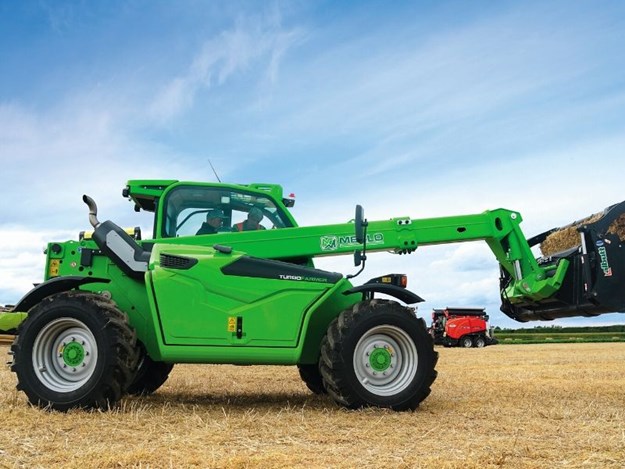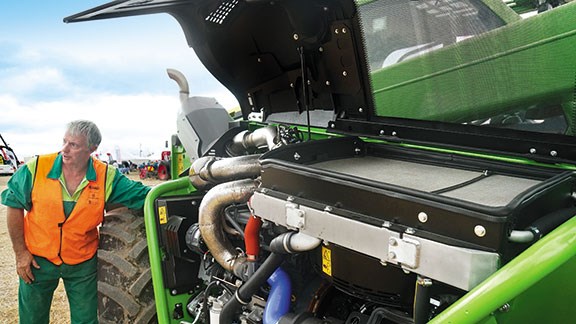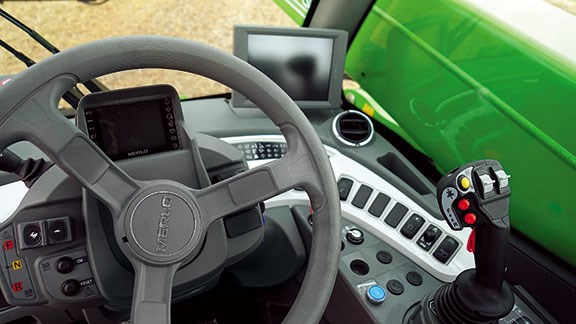Brent Lilley gives his thoughts on the Merlo Turbo Farmer 42.7 CS 140 telehandler
 |
|
The Merlo Turbo Farmer is compact, powerful and versatile
|
With many European manufacturers refining their designs over the last 30 years, the telehandler has evolved into a truly versatile machine. A good example is Merlo, a company that has been building equipment since 1964 and more specifically telehandlers since 1981. Its factory in Cuneo in Northern Italy has been dedicated to the continual improvement of these machines.
Because Merlo builds a wide range of telehandlers designed for construction through to farming and everything in between, the machines are built around a modular design. A central heavy-duty steel plate chassis forms the backbone of each machine, and then the components attached to this can be purpose selected to ensure the machine suits its end use.
Recently, we caught up with Power Farming Merlo specialist Ken Bill, who showed us around a Merlo Turbo Farmer 42.7 CS 140. Designed for use on farms, we set it up with a bucket grab and carried out some work with straw bales in a stubble field to assess how the machine performed.
ENGINE
Following on with the modular design, the engine bay sits in a heavy-duty 70mm solid round bar form, which also acts as a protective bumper. It attaches to the chassis on hefty solid steel dowels and is secured with large bolts.
The engine itself is a 136 horsepower (101kW) four-cylinder 3.6-litre Deutz engine. It meets Tier 4 final standards using AdBlue and a diesel particulate filter (DPF). When a cleaning burn is required, the driver is alerted in the cab and a toggle switch can activate or delay it (for example if working indoors).
As the engine is mounted front to back on the machine, there seems to be more space around it than many competitors’ designs. It allows easy access for servicing the engine and transmission. Service intervals are 500 hours on the engine oil and 1,200 hours on the hydraulic and transmission oils. A reverse fan has become pretty much a standard feature on a modern telehandler and on the Merlo this runs off its own hydraulic pump, which ensures it always runs at the correct speed. It can be reversed with a switch in the cab and will automatically switch back after two minutes.
An interesting option available from the factory on all Merlo telehandlers is a rear power take off. Easily bolted into the modular design, a quick internet search shows pictures of people towing mixer wagons and even balers behind their Merlo machines.
 |
|
Ken Bill from Power Farming points out the machine’s key features
|
DRIVE TRAIN
Drive to the wheels is delivered by Merlo’s proven HST drive system via a two-speed range transfer gearbox. Powered by a dedicated electronically-controlled hydraulic pump, at low speed the two motors work together to provide maximum torque and acceleration. At higher transport speeds, the second hydrostatic motor is disengaged and the oil powers the remaining motor to full speed.
Two ranges can be selected from the cab: 0–14km/h and 0–40km/h, giving the operator more control over the machine at slower speeds. The telehandler must be stopped in order to change ranges – a feature that helps prevent damage and for added safety.
Designed by Merlo, the system uses high-quality, well-known Rexroth components. The transmission runs on its own closed-circuit hydraulic system to reduce the chances of wear from contamination. In operation, this transmission set-up works extremely well. It’s responsive at low operating speeds and accelerates smoothly up to 40km/h with no interruptions from gear changes. The machine is in four-wheel drive full time.
The transmission also has a handy fuel saving setting. When set to heavy load, the maximum engine rpm is available at all times. When in eco mode, it will still achieve top speed but at an engine rpm of 1,900, which is ideal for road travel to save fuel.
The machine sits on portal axels, designed and built in-house by Merlo and incorporate a double universal joint (sealed and greased for life), as well as a ball and pinion gear in the hub. This all adds up to create significantly higher ground clearance than many other telehandlers on the market. With raising the overall height, tie rods are tucked in behind the axles to prevent damage, and it runs on 405 70 R24 tyres all round.
I must admit to being a little surprised to find dry disc brakes on each axle, although it turns out there is some logic behind it. Most of the machine’s braking is taken care of by the transmission, which brakes to neutral anyway. There is said to be less friction also, which leads to fuel savings, and because they are not enclosed, the brakes are easy to access and service. As you would expect from a telehandler, there is a choice of three steering modes: front wheel, four wheel, and crab steering. These can be easily selected with a switch in the cab, making it versatile and manoeuvrable whichever direction you need to work in. What does differ from the norm is the way the Merlo realigns the wheels when changing modes. Simply take the machine to full lock in either direction and then back, and it automatically aligns the rear wheels. It’s a refreshingly simple process.
 |
|
The Merlo has an impressive max lifting height of 7.1m
|
BOOM
Merlo has come up with a unique boom construction system using heavy folded sheet steel with automated welding on the neutral axis (the point with the least amount of stress), which allows the production of lighter but stronger booms.
Active boom suspension in the main boom is great when carrying loads, allowing some bounce to level out the ride for the operator. The fact it turns off automatically when the machine is travelling at slower than three kilometres per hour gives precision movements when loading or unloading. It can also be manually turned off with a switch in the cab.
The hydraulic system uses a single load sense pump, which puts out an impressive 150 litres per min, and there is a 110-litre reservoir at the rear of the machine. Cycle times for the boom up/down and in/out seemed to be quick and smooth.
At the end of the boom is a Merlo-designed headstock, which incorporates hydraulic locking for attachments and a third service.
The clever part is the Merlo attachment recognition system – this uses an radio frequency identification reader in the headstock that allows the telehandler to recognise the attachment that is fitted, so it automatically knows the maximum lifting weights and heights. Of course, this works with genuine Merlo attachments but is becoming an industry standard with many other manufacturers getting on-board.
As standard, every Merlo is fitted with a weighing system incorporated into the main lift cylinder. This can be tared with any attachment and weigh any time or with the boom at any angle. This is one of those things that you don’t realise how much you will use it until you have it, from loading ingredients into a mixer wagon to weighing bales or fertiliser bags.
In practice, it was extremely accurate. It weighed a bale accurately on the front and could also weigh a person stepping onto the bucket as well. It also had repeated accuracy whatever the boom angle. The screen in the cab has a memory, allowing you to record weights by pushing a button to weigh, or it can be set to automatically weigh and record at a set boom angle – another great idea when loading or unloading, as saved weights can be edited, deleted and tallied up.
 |
|
The dash is well laid out with everything in easy reach
|
CAB
A standout feature from Merlo is its cab suspension. Delivering an impressively smooth ride, the cab sits on mechanical guides, using a single hydraulic cylinder under the cab to allow it to move up and down. Self-centring, it also adjusts to the weight in the cab. Put to task out in a stubble paddock, it worked impressively well; running over pivot ruts at 30 km/hr they were barely noticeable. The cab suspension can be turned off at the simple flick of a switch. The cab also incorporates fully certified falling object and rollover protection structures.
CONTROLS
Firstly, it’s great to find a forward reverse lever on the left-hand side of the steering wheel, particularly when as a farmer, you are used to a left-hand shuttle lever on a tractor. Even better is the fact that there are also buttons on top of the right-hand joystick for forward, reverse, and neutral, catering for all driving styles. The right-hand joystick mainly controls the boon movement but also has roller switches on top, allowing the operator to control the third service and boom telescope with their thumb.
Toggle switches are well laid out around the sweeping dash, with the ability to control most features on the machine, and a small but clear colour dash displays the vital statistics such as rpm, speed, fuel, and AdBlue levels. Near the front right pillar is the display for the Merlo dynamic load control system. This has been designed to keep operators within the safe working limits of the machine. It displays all relevant information on a clear, easy-to-see screen.
Across the bottom, the boom height, length and angle are shown. Up the side displays the current weight being carried, the percentage of the allowable weight this is, and what attachment is fitted (if the machine can recognise it).
The main box displays the load chart for the current attachment, showing in real time where the boom is positioned and what the maximum safe lift height and angles are. The system will lock the machine out if it’s overloaded and out of the safe working range.
Display lights of green, orange and red are located inside and outside the cab to let the operator and those around the machine know if it is operating safely. A reversing camera is fitted as standard for safety and displays on the monitor when reverse is selected.
Next to the brake and the accelerator is a third pedal – the inching pedal. This allows the operator to inch forward or hold the machine against the pile when loading. Having a separate pedal allows more precise control and causes less wear than using the brakes.
A ‘digger mode’ can be selected with a toggle switch and is useful for fuel saving or working in enclosed spaces. The engine rpm automatically increases from idle when the hydraulics demand for it – if the boom is raised for example – and then drops back to an idle when not required.
Cruise control is another great feature for road travel and works much like a vehicle; it can be set to hold any speed so the operator doesn’t need to keep his foot on the accelerator.
 |
|
As standard, every Merlo is fitted with a weighing system incorporated into the main lift cylinder
|
Verdict
Merlo has been in the New Zealand market for some time now and shows consistent refinement and improvement as it continues developing its telehandlers. The modular design concept really allows complete tailoring of the machine to the end user. The hydrostatic variable transmission with smooth acceleration to top speed, boom, and importantly cab suspension offer a comfort level for the driver that is second to none in the telehandler market.
It’s also impressive to see how focused the company is keeping the people in and around these machines safe, with features such as on-board weighing, attachment recognition, and a dynamic load recognition ensuring the machine exceeds industry safety standards.
PLUSES
- Modular design allows tailored machines
- Economical four-cylinder 136hp Deutz engine
- Hydrostatic variable 40km/hr transmission
- Impressively smooth cab suspension
- Boom suspension and attachment recognition
- Accurate on-board weighing and recording
- Dynamic load system for safe operation
MINUSES
I’m slightly sceptical of dry brakes in sometimes harsh conditions
SPECS: Merlo Turbo Farmer 42.7 CS 140
Engine Deutz 3.6L, 4-cylinder, Tier IV
Horsepower 136hp
Transmission Hydrostatic CVT
Max speed 40km/hr
Hydraulic pump load-sensing 150L/min
Weight 7,450kg
Lifting capacity 4,200kg
Max lifting height 7.1m
Max reach 3.7m
Cab Suspended with FOPS/ROPS protection
Photography: Laura Batten



.jpg)